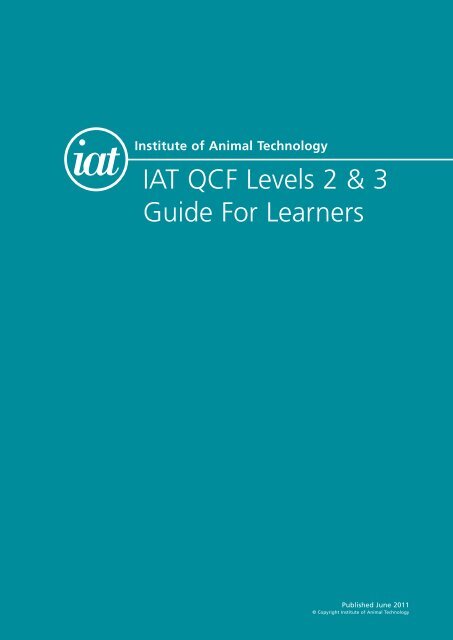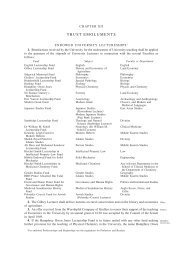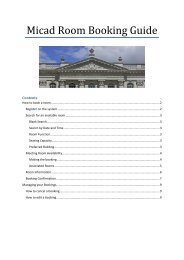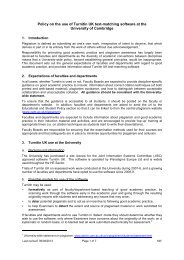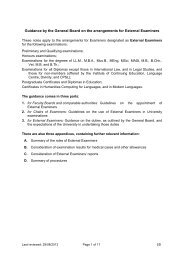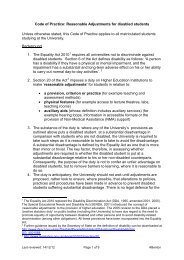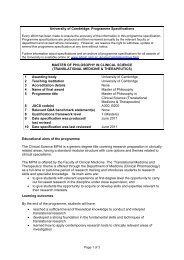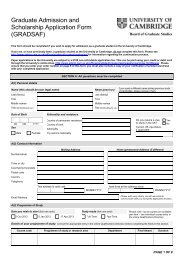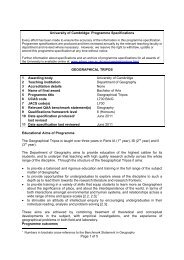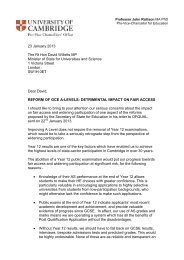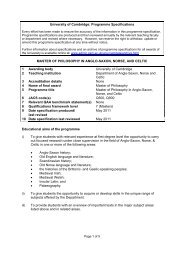IAT QCF Guide for Learners
IAT QCF Guide for Learners
IAT QCF Guide for Learners
You also want an ePaper? Increase the reach of your titles
YUMPU automatically turns print PDFs into web optimized ePapers that Google loves.
Institute of Animal Technology<br />
<strong>IAT</strong> <strong>QCF</strong> Levels 2 & 3<br />
<strong>Guide</strong> For <strong>Learners</strong><br />
Published June 2011<br />
© Copyright Institute of Animal Technology
Institute of Animal Technology<br />
Introduction<br />
The Qualification and Credit Framework (<strong>QCF</strong>) is the structure <strong>for</strong> creating and<br />
accrediting learning in England, Wales and Northern Ireland (Scotland has its own<br />
framework). The <strong>QCF</strong> is designed to provide learners, learning providers and<br />
employers with an inclusive and flexible regulated qualifications framework<br />
containing units and qualifications that recognise the widest possible range of quality<br />
assured learner achievements. Learner achievements are recognised in the <strong>for</strong>m of<br />
credits achieved by successfully completing units.<br />
Further in<strong>for</strong>mation on the <strong>QCF</strong> can be found at www.iat.org.uk<br />
Page 2 Syllabus
Institute of Animal Technology<br />
Contents<br />
Introduction 2<br />
How the <strong>QCF</strong> works 4<br />
Levels 4<br />
Assessment 4<br />
Grading the <strong>IAT</strong> units 5<br />
Questions 6<br />
General 6<br />
<strong>IAT</strong> Level 2 Diploma in Laboratory Animal Husbandry 8<br />
<strong>IAT</strong> Level 2 Diploma in Laboratory Animal Science and Technology 8<br />
<strong>IAT</strong> Level 3 Diploma in Laboratory Animal Science and Technology 8<br />
<strong>IAT</strong> <strong>QCF</strong> Levels 2 & 3 <strong>Guide</strong> For <strong>Learners</strong> Page 3
Institute of Animal Technology<br />
How the <strong>QCF</strong> works<br />
All <strong>QCF</strong> qualifications are built up from units. A unit is a piece of learning, usually (but not necessarily) smaller than<br />
a whole qualification. This makes learning more flexible as people can complete units at a pace and in a way that<br />
suits their circumstances and helps providers and employers to create learning programmes that are better suited<br />
to individual needs. Each unit is designed so you see what the learning or training involves and what will be<br />
achieved by the learner.<br />
A unit is defined as a coherent set of learning outcomes and related assessment criteria with a title, credit value<br />
and level. Each unit must:<br />
● be capable of being individually assessed<br />
● be capable of contributing towards at least one qualification<br />
Units can be generic and applicable to a range of contexts and qualifications. In<strong>for</strong>mation on delivery,<br />
content/coverage, assessment methods or learning modes are not included within the definition of a unit but can<br />
be specified within the supporting documentation. This explains the layout of the new syllabus. The supporting<br />
in<strong>for</strong>mation can be found towards the end of the syllabus, after the unit specification.<br />
<strong>QCF</strong> units will replace the <strong>IAT</strong> First Certificate, First Diploma and National Certificate modules. The mapping of <strong>QCF</strong><br />
units to the modules is shown on page 8.<br />
Levels<br />
The level describes the degree of challenge required to complete the unit. Each unit must be assigned a level. The<br />
<strong>IAT</strong> are interested in level 2 (e.g. GCSE grade C or above, First Diploma, NVQ level 2) and level 3 (e.g. A level,<br />
National Diploma, NVQ level 3). In addition each unit must have a credit value.<br />
The <strong>IAT</strong>’s Educational Policy above level 3 is that learners should then progress into Higher Education.<br />
Assessment<br />
The table overleaf shows the assessment strategy. It is about finding the right balance of assessment methods and<br />
trying to develop animal technologists with a full range of capabilities including a good recall of relevant<br />
in<strong>for</strong>mation <strong>for</strong> the workplace. The <strong>IAT</strong> has set a broad assessment method <strong>for</strong> each unit but Centres are free to<br />
design their own specific assessments within the broad framework.<br />
Page 4 <strong>IAT</strong> <strong>QCF</strong> Levels 2 & 3 <strong>Guide</strong> For <strong>Learners</strong>
Institute of Animal Technology<br />
NQF Module <strong>QCF</strong> unit Assessment<br />
Housing and routine care of Laboratory animal housing Competency or written laboratory<br />
animals and routines assessment<br />
Breeding and feeding The production of laboratory Unit test<br />
animals<br />
Laboratory animal nutrition<br />
Competency or written assessment<br />
Ethics, law, euthanasia and health Introduction to ethics and Unit test<br />
and safety<br />
laboratory animal facility legislation<br />
Animal husbandry and health Laboratory animal husbandry Competency or written<br />
and health<br />
assessment<br />
Biological science Laboratory animal biology Written assessment<br />
Physical science Animal facility physical science Written assessment<br />
ICT, Communication & Numeracy Numeracy <strong>for</strong> animal technologists Written assessment<br />
Communication <strong>for</strong> animal<br />
technologists<br />
In<strong>for</strong>mation Communication<br />
Technology <strong>for</strong> animal technologists<br />
Written assessment<br />
Written assessment<br />
Management of the animals’ Housing and biosecurity barriers Written assessment<br />
environment and disease control in laboratory animal facilities<br />
Disease control<br />
Laboratory animal welfare<br />
Written assessment<br />
Unit test<br />
Scientific procedures Scientific procedures Written assessment<br />
Animal breeding and genetic<br />
alteration<br />
The use of genetically altered animals Written assessment<br />
Management of breeding colonies<br />
Written assessment<br />
Ethics, animal legislation, transport Ethics and laboratory animal facility Unit test<br />
and good laboratory practice legislation<br />
Animal transportation<br />
Written assessment<br />
Cell biology Animal cell biology Written assessment<br />
Physiology Laboratory animal physiology Unit test<br />
Grading the <strong>IAT</strong> units<br />
Each assessment is graded as a Pass, Merit, Distinction. The grade is based on the learning outcomes and grading<br />
criteria. To achieve the grade, you must meet ALL of the learning outcomes and grading criteria associated with<br />
the particular grade being awarded.<br />
If you fail to achieve all of the learning outcomes and grading criteria associated with the Pass grade, the unit is<br />
referred and you are given a chance to bring the work up to the appropriate standard. The final grade <strong>for</strong> each<br />
unit will be displayed on the final Certificate and the Certificate of Achievement. There is no overall grade <strong>for</strong> the<br />
qualification.<br />
<strong>IAT</strong> <strong>QCF</strong> Levels 2 & 3 <strong>Guide</strong> For <strong>Learners</strong> Page 5
Institute of Animal Technology<br />
Questions<br />
General<br />
Why is the <strong>IAT</strong> changing so soon?<br />
These changes were laid down in 2008 <strong>for</strong> the move over to the <strong>QCF</strong> in 2010. All Awarding Bodies wanting to keep<br />
their qualifications on the national framework will have to move their qualifications on to the <strong>QCF</strong>. The <strong>IAT</strong> have<br />
planned <strong>for</strong> this and the changes will be minimised as far as is possible <strong>for</strong> Centres and learners.<br />
What are the new units called and how do they compare with existing modules?<br />
Existing NQF Module NEW <strong>QCF</strong> unit Assessment Option<br />
Housing and routine care of Laboratory animal housing Competency or written laboratory<br />
animals and routines assessment<br />
Breeding and feeding The production of laboratory Unit test<br />
animals<br />
Laboratory animal nutrition<br />
Competency or written assessment<br />
Ethics, law, euthanasia and health Introduction to ethics and Unit test<br />
and safety<br />
laboratory animal facility legislation<br />
Animal husbandry and health Laboratory animal husbandry Competency or written<br />
and health<br />
assessment<br />
Biological science Laboratory animal biology Written assessment<br />
Physical science Animal facility physical science Written assessment<br />
ICT, Communication & Numeracy Numeracy <strong>for</strong> animal technologists Written assessment<br />
Communication <strong>for</strong> animal<br />
technologists<br />
In<strong>for</strong>mation Communication<br />
Technology <strong>for</strong> animal technologists<br />
Written assessment<br />
Written assessment<br />
Management of the animals’ Housing and biosecurity barriers Written assessment<br />
environment and disease control in laboratory animal facilities<br />
Disease control<br />
Laboratory animal welfare<br />
Written assessment<br />
Unit test<br />
Scientific procedures Scientific procedures Written assessment<br />
Animal breeding and genetic The use of generally altered animals Written assessment<br />
alteration<br />
Management of breeding colonies Written assessment<br />
Ethics, animal legislation, transport Ethics and laboratory animal facility Unit test<br />
and good laboratory practice legislation<br />
Animal transportation<br />
Written assessment<br />
Cell biology Animal cell biology Written assessment<br />
Physiology Laboratory animal physiology Unit test<br />
Page 6 <strong>IAT</strong> <strong>QCF</strong> Levels 2 & 3 <strong>Guide</strong> For <strong>Learners</strong>
Institute of Animal Technology<br />
How do the qualifications link to the <strong>IAT</strong> membership?<br />
The rules <strong>for</strong> <strong>IAT</strong> Membership can be found on the <strong>IAT</strong> website. The <strong>IAT</strong> Level 2 Diploma in Laboratory Animal<br />
Science and Technology and the Membership module will lead to the Intermediate Membership level. <strong>IAT</strong> Level 3<br />
Diploma in Laboratory Animal Science and Technology and the Membership module will lead to the full<br />
Membership (M<strong>IAT</strong>).<br />
Will the registration process change?<br />
There will be a single registration one off fee <strong>for</strong> each qualification. This will replace the individual module<br />
registration fee. <strong>Learners</strong> will be registered <strong>for</strong> the full qualification.<br />
What changes will I need to make as a:<br />
● Centre<br />
● Learner<br />
Learner: learners will be required to do less assignments and some more unit tests. They will take more smaller<br />
units but otherwise there will not be any obvious changes.<br />
Will the 5 year rule on exemptions still apply?<br />
No, this will no longer be used as it is discouraged on the <strong>QCF</strong>.<br />
I presume proxy exemptions no longer apply?<br />
No, there will be a list of proxy qualifications as it becomes clear which <strong>QCF</strong> qualifications are relevant. <strong>Learners</strong><br />
can still apply <strong>for</strong> recognition of prior learning through the normal procedures. Details are on the <strong>IAT</strong> website.<br />
What in<strong>for</strong>mation do I need to present to the Centre to apply <strong>for</strong> an exemption from a unit?<br />
The Moderator will require evidence of your prior learning. Generally it will be through a certificate showing your<br />
prior per<strong>for</strong>mance. You will need evidence that the learning covered relevant topics at the appropriate level, so a<br />
list of modules or syllabus would also help if it is a qualification not on the proxy list. For non UK qualifications<br />
you may need to have them translated or an independent assessment of their level.<br />
<strong>IAT</strong> <strong>QCF</strong> Levels 2 & 3 <strong>Guide</strong> For <strong>Learners</strong> Page 7
Institute of Animal Technology<br />
What are the new units?<br />
Unit title Level Credit<br />
<strong>IAT</strong> Level 2 Diploma in Laboratory Animal Husbandry (<strong>QCF</strong>) 600/0558/0<br />
Laboratory animal housing and routines F/602/5879 2 12<br />
The production of laboratory animals T/602/5880 2 8<br />
Laboratory animal nutrition A/602/5881 2 4<br />
Introduction to ethics and laboratory animal facility legislation F/602/5882 2 12<br />
Laboratory animal health and husbandry J/602/5883 2 12<br />
<strong>IAT</strong> Level 2 Diploma in Laboratory Animal Science and Technology (<strong>QCF</strong>) 600/0559/2<br />
Laboratory animal housing and routines F/602/5879 2 12<br />
The production of laboratory animals T/602/5880 2 8<br />
Laboratory animal nutrition A/602/5881 2 4<br />
Introduction to ethics and laboratory animal facility legislation F/602/5882 2 12<br />
Laboratory animal health and husbandry J/602/5883 2 12<br />
Laboratory animal biology Y/602/6049 2 8<br />
Animal facility physical science L/602/6050 2 8<br />
Numeracy <strong>for</strong> animal technologists D/602/6053 2 4<br />
Communication <strong>for</strong> animal technologists Y/602/6052 2 4<br />
In<strong>for</strong>mation Communication Technology <strong>for</strong> animal technologists R/602/6051 2 4<br />
<strong>IAT</strong> Level 3 Diploma in Laboratory Animal Science and Technology (<strong>QCF</strong>) 600/0560/9<br />
Housing and biosecurity barriers in laboratory animal facilities A/602/5976 3 8<br />
Disease control M/602/6039 3 12<br />
Laboratory animal welfare H/602/6040 3 8<br />
Management of breeding colonies K/602/6041 3 12<br />
The use of genetically altered animals in research M/602/6042 3 8<br />
Scientific procedures T/602/6043 3 12<br />
Ethics and laboratory animal facility legislation A/602/6044 3 12<br />
Animal transportation J/602/6046 3 8<br />
Animal cell biology L/602/6047 3 8<br />
Laboratory animal physiology R/602/6048 3 12<br />
Page 8 <strong>IAT</strong> <strong>QCF</strong> Levels 2 & 3 <strong>Guide</strong> For <strong>Learners</strong>
Contacts and further in<strong>for</strong>mation<br />
can be obtained from:<br />
The Institute of Animal Technology<br />
Registered Office<br />
5 South Parade<br />
Summertown<br />
Ox<strong>for</strong>d<br />
OX2 7JL<br />
Website: www.iat.org.uk<br />
Email: info@iat.org.uk<br />
Media & Public Relations<br />
Carpe Diem Corporate Communications<br />
18 Wansdyke Road<br />
Great Bedwyn<br />
Malborough<br />
Wiltshire<br />
SN8 3PW<br />
Tel: 01672 871 371<br />
Fax: 01672 871 372<br />
Email: mediaservices@iat.org.uk<br />
Syllabus V1-07 Levels 2-3


